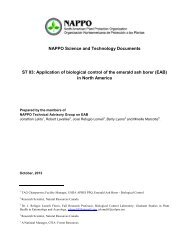NAPPO Regional Standards for Phytosanitary Measures (RSPM)
NAPPO Regional Standards for Phytosanitary Measures (RSPM)
NAPPO Regional Standards for Phytosanitary Measures (RSPM)
You also want an ePaper? Increase the reach of your titles
YUMPU automatically turns print PDFs into web optimized ePapers that Google loves.
• Visual inspection.• Host sampling.• Verification of trap and lure efficacy.• Placement and recovery of marked target pest(s).• Regular reviews of survey documentation.• Audits of trap placement and servicing.• Confirmation of identifier competency.2.3 Movement controlsEffective phytosanitary measures are required to prevent the entry of regulated nonquarantinepest(s) above tolerances established by the NPPO and to prevent the introductionof quarantine pests known to attack hosts present in the ALPP. The key elements mayinclude, among others:• Identification of the pathways and regulated articles that require control to maintain theALPP.• Establishment of an inspection program <strong>for</strong> regulated articles moving into the ALPP.• Maintenance of sampling records, identification of intercepted specimens, verification ofdocuments, confirmation that required treatments occurred, and documentation of anyother phytosanitary procedures.3. Verification of an Area of Low Pest PrevalenceThe NPPO should verify that the requirements to maintain the ALPP continue to be met. Inaddition to the surveillance activities, control measures, and movement controls detailed inthis standard, field and road station inspections and host sampling in the ALPP should becarried out. ALPP status may be verified by a stated number or frequency of inspections asdelineated in the bilateral workplan. The absence of target pests on commodities moved outof the ALPP can also contribute to verification that the ALPP is being maintained.4. Change in the Status of an Area of Low Pest PrevalenceThe detection of the target pest(s) that exceeds the threshold level within the ALPP shouldresult in the implementation of the emergency action plan as specified in Section 6 of thisstandard and immediate notification of trading partners. The main cause <strong>for</strong> a change in thestatus of the ALPP is confirmation of a reproducing population of the target pest(s) abovethe threshold level in the ALPP, detection of a quarantine pest(s) during inspection of hostproducts, or the detection of a regulated non-quarantine pest above the tolerance level.These situations should result in immediate suspension of the ALPP status. ALPP statusmay be terminated if appropriate emergency actions are not taken in response to thedetection of a target pest(s) above the threshold level. Examples of other possible reasons<strong>for</strong> change in the status of the ALPP are given in Appendix C.The NPPO should take appropriate emergency actions to delimit, contain, control targetpest(s) or eradicate other quarantine pests detected in the ALPP according to the bilateralworkplan. A population level higher than the accepted threshold should result in increasedlevels of phytosanitary actions. Suspension of ALPP status will remain in effect until it is<strong>RSPM</strong> No. 20Guidelines <strong>for</strong> the Establishment, Maintenance and Verification of an Area of Low Pest Prevalence <strong>for</strong> Insects Page 11
















